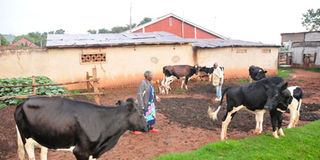Prime
Realising the potential of farming in urban areas

Above, the Kiizas with some of the cows and other livestock that they rear. PHOTO BY MICHAEL KAKUMIRIZI
What you need to know:
Many people in rural areas are abandoning farming, which they feel does not pay, for other occupations in urban areas that they think will earn them better income. Ironically, city dwellers are turning to urban agriculture as they realise its potential to enhance their livelihoods. Farahani Mukisa talked to the Kiizas, a couple who are urban farmers
My name is Florence Zahura, a resident of Masajja Parish in Makindye Municipality, Kampala City. My husband and I are retired civil servants and we practise urban agriculture. We use approximately half an acre of land.
On it, we keep cattle, quails and goats and grow some crops as well. However, from 2000, we discontinued the goats as keeping them demanded a lot yet they are not as profitable as cattle on a small scale.
Being from families with a bent towards animal husbandry, it is more than a hobby for us to go into urban agriculture.
We were living in a rented home in Kampala Central, but when we saved some money, I advised my husband to buy a piece of land on the outskirts of the city, which he agreed to.
We started this in 1993 with a capital of Shs2m. It is from that money that we bought three indigenous-breed cows and also constructed a kraal.
But with time, we realised these breeds were not yielding to our expectations. We sold them, added more money and bought two Friesian hybrid cattle. These were better in terms of the yields.
They provided about 10 litres of milk per day. Today, we have a total of 43 heads of cattle. We keep only 20 of them here and the others at a farm in Hoima District.
With this kind of farming, one needs to be hardworking and patient because since the animals are under zero grazing, they are mostly dependent on you. If you relax, they will relax too, and the losing buck is on your end.
You require passion and effort to get the best of it. For instance, if you want to get more milk you need to consult for what are best foods to feed the animals.
In our case, we have since realised that feeding them with animal cake and chicken feeds, we get more milk compared to when we use matooke peels, among others.
Then, we started a small vegetable farm, mainly our home consumption, but often the production surpass our needs and we sell the surplus to our neighbours.
We are also trying out rearing quails. This is an enterprise, we would advise many people in urban centres to start; the market is high and readily available.
What is interesting about quails is that they require very little space, which everyone in urban centres can afford.
We keep the quails in shelves, which each home can have on a veranda or in a kitchen or in the backyard of the house for those with fenced homes.
We have 100 quails, and every day they give us at least 60 eggs, which we sell at Shs1,000 each. This kind of income can sustain an urban family or household.
In addition to 60 quail eggs a day. From the cows, we get at least 100 litres of milk. Each one produces about three litres of milk, which is about 60 litres and 50 litres in the morning and the evening.
A litre is sold at Shs1,500 during times when it is in plenty and Shs2,000 when there is scarcity, like during the dry seasons and school holidays.
Our niche is in the quality we provide. People pick our milk from our home, and it is these people refer others to us. Because we decided to sell our milk the way we have milked it, this has earned us good market from the community.
Once in a while, we sell some green vegetables, each bundle is at least Shs1,000.
Like it is called, urban farming, the issue of space is a big challenge. The number of cattle grows and we may want to keep them but do not have the space. So we end up selling them off. Also, the increase in numbers means increased costs of feeding and vaccination.
Labour is challenging if you do not have a vehicle to transporting the feeds. Thus, the option is hiring manual labour, which is expensive. I have three employees and each is paid Shs120,000 per month.
These are most challenging aspects of urban farming, and once they are overcome, you will not regret venturing into it.
Among the achievements from farming, we built a house and paid for our children’s education. We bought land in Hoima where we take the surplus animals.
In the future, we plan to introduce goats on this farm since we had stopped keeping them in the city because of space considerations.
We plan to set up training centre for young people to realise the potential in farming, because it hurts us to have them abandon agriculture to seek jobs they do not actually find.




